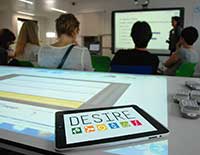Science teachers: using education research to make a difference Inspire article
As a teacher of science, technology, engineering or mathematics (STEM), you are in a perfect position to encourage more students to take up STEM studies and careers. But what are the best ways to inspire students and achieve this goal? Research projects in science education can really help, but…

position to encourage more
students to take up STEM
studies and careers.
Image courtesy of
Turnervisual/ iStockphoto
The DESIRE project (Disseminating Educational Science, Innovation and Research in Europe) was set up to tackle the problem of making educational research more accessible to teachersw1. From 2011 to 2013, a range of STEM professionals – including science teachers, science communicators and policymakers – were consulted to identify the main challenges that science teachers face in accessing new ideas from STEM educational research, and the best ways to make research available to help develop innovative teaching.
Go online
The most efficient way to access new information is through online communities, websites and blogs. Some online portals are a central point to access information on a wide range of resources: these include eTwinningw2, Scientixw3, inGeniousw4 and the Learning Resource Exchange platformw5. Being active in topic-based online communities is a great way to create and share ideas with other STEM professionals from universities and the private sector, as well as teaching. Moodlew6 and Edmodow7 are recognised by many teachers as ideal social media as they are controlled, secure online areas. Pearltreesw8 helps to save links and explanations, and Diigow9 enables resource sharing.
Attend events

research be effectively used
in teaching?
Image courtesy of European
Schoolnet
Conferences and other face-to-face events are good opportunities to meet the innovators of new teaching practices, and also to network with other teachers. Attending a training course can have a long-lasting impact on your teaching and help you to become more confident about using new approaches in class. You can share out opportunities to attend events between yourself and your colleagues, so that you all have a chance to be inspired. On your return, make the most of the knowledge you have gained by discussing it with your colleagues.
Participate
Even if there is limited time and money available to you to attend events in person, you can still participate in European and national STEM education projects, for example through European Schoolnetw10 or other national and international bodies active in formal and informal STEM education. Involvement in such activities will enable you to benefit from the experience of the professionals leading these initiatives, and to share your own knowledge. By doing this, you will in turn enhance the way STEM education resources are developed and communicated in a way that takes your needs and constraints into account.
Inspire

STEM educational research to
inspire their students?
Image courtesy of Shutterstock
You can inspire colleagues to participate in STEM education projects and use the results of research by showing them the advantages – namely, that it will reinforce their STEM teaching skills and keep their knowledge up to date. Perhaps share success stories from your own experience, or create a small exhibition or event with your students to display the new insights they have obtained through using alternative methods. Involving your head teacher is key, as this will help to motivate your colleagues and provide professional recognition for your efforts.
Although lack of time is a major challenge for all teachers, remember that most new methods and tools are designed to make teaching more efficient. Once you are familiar with them, they can save you time and effort in teaching your STEM curriculum. So think about the long-term vision you have for your classes.
Acknowledgements
DESIRE is one of many projects offered to science teachers by European Schoolnet, a network of 30 ministries of education in Europe. Other major platforms are Scientixw3 and Ingeniousw4.
The DESIRE project has been funded with the support of the Lifelong Learning programme of the European Union. It is carried out by European Schoolnet together with INDIRE (Agenzia Nazionale per lo Sviluppo dell’Autonomia Scolastica), Universitat Autònoma de Barcelona, Danish Science Communication (Dansk Naturvidenskabsformidling) and Ecsite (the European network of science centres and museums). This article reflects the views only of the authors, and the European Commission cannot be held responsible for any use that may be made of the information contained herein.
Web References
- w1 – The DESIRE project and its results.
- w2 – eTwinning, a learning community that promotes school collaboration and teachers’ professional development.
- w3 – Scientix, the community for science education in Europe, which aims to facilitate sharing of know-how and best practices.
- w4 – inGenious, which has resources to encourage interest in science education and careers among young Europeans.
- w5 – Learning Resource Exchange for schools, which provides educational content from many different countries.
- w6 – Moodle, a virtual learning environment and social community for teachers.
- w7 – Edmodo, a social learning platform for teachers, students, and parents.
- w8 – Pearltrees, a tool that acts as an extension of internet browsers to reference favourite web pages.
- w9 – Diigo, a research tool and knowledge-sharing community.
- w10 – European Schoolnet, where you can subscribe to newsletters for opportunities to participate in education projects.





